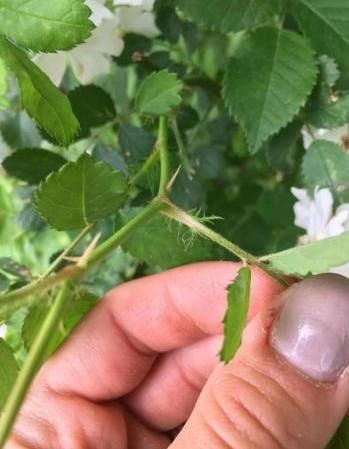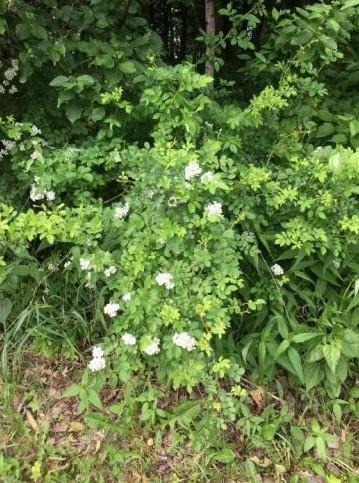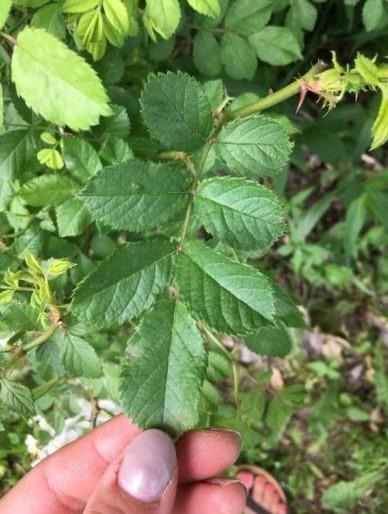By Meaghan Anderson and Bob Hartzler
Multiflora rose (MFR) is a common weed in pastures, CRP, timber and other areas that are not annually disturbed. Now is an appropriate time for treatment of these weeds in pastures and other areas they invade.
Identification
MFR can grow to 5-10 ft tall, and spreads by both seed and arcing canes that root at the tips. It produces an abundance of white flowers in late May or early June. Leaves are key to identifying MFR from other roses. Each pinnately compound leaf contains 5-11 toothed leaflets. The base of each leaf petiole has a stipule resembling a fringe of hairs; cultivated and native roses have winged stipules. For more on identification, check out this Encyclopedia article.

Control with herbicides
Numerous herbicides provide effective control of MFR when applied at the right time and manner. One of the best times to treat MFR is when plants are fully leafed out in the late spring; some products specify that treatments are most effective when plants are in early or mid-flower. The following table provides information on some of these herbicides. Check individual product labels and the invasive species control database listed below for more specific information, including suggested product rates for broadcast treatments to control MFR. Many of the active ingredients are off-patent and sold under different trade names. When using spot treatments it is important to achieve thorough coverage of the entire plant.
Table 1. Herbicide treatments appropriate for foliar treatments of MFR
Herbicide | Herbicide Group Number | Example products | Rate for spot treatments | Pastures | Notes |
|---|
Dicamba | 4 | Banvel, Clarity | 1% solution | Yes | |
Glyphosate | 9 | Roundup, many others | 1% solution | Yes (spot treatment) | Will kill pasture grasses |
Imazapyr | 2 | Arsenal, Stalker, Habitat | 0.5-1% solution | Yes | Less selective than Group 4 products |
Triclopyr + 2,4-D | 4 | Crossbow, Chaser | 1-1.5% solution | Yes | |
Metsulfuron | 2 | Escort XP | 0.02 oz a.i./gal (spot treatment) | Yes | Pasture grass tolerance may vary |
Metsulfuron + 2,4-D + dicamba | 2, 4 | Cimarron Max | 0.5 oz/acre (herb. part A) + 2 pt/acre (herb. part B) | Yes |
Picloram | 4 | Tordon 22K, component of Grazon P+D | Check product label | Yes |
Aminopyralid + 2,4-D | 4 | GrazonNext | 2.1 pt/acre + 0.25% v/v NIS | Yes |
Precautions should be taken to prevent off-target movement that may result in injury to desirable plants. Check labels for any restrictions that may pertain to use near water resources and for grazing of treated areas.
Alternative control options
This plant may be managed with mechanical efforts with significant effort. Mowing plants 3-6 times during the growing season for multiple years should significantly reduce MFR populations. Additionally, mechanical removal by pulling or digging to remove the root crown and as many roots as possible is an effective method to eliminate plants.

Information regarding both chemical and non-chemical control tactics are provided at the Midwest Invasive Plant Network control database.
As with most weeds, controlling multiflora rose requires a long-term commitment. In areas with established populations, the seed bank will allow reinfestation. Thus, follow up efforts are required to control plants that survive earlier treatments and plants that emerge from the seed bank. Proper pasture management that enhances competitiveness of the pasture grasses will reduce recruitment of new plants from the seedbank.

Source : iastate.edu